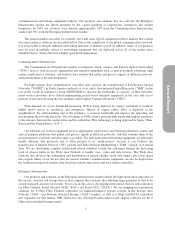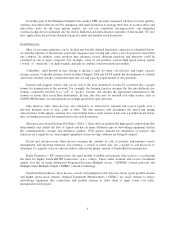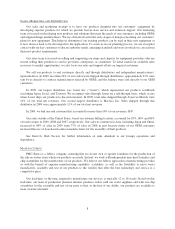Adaptec 2009 Annual Report Download - page 13
Download and view the complete annual report
Please find page 13 of the 2009 Adaptec annual report below. You can navigate through the pages in the report by either clicking on the pages listed below, or by using the keyword search tool below to find specific information within the annual report.
Annual Report
We may fail to meet our forecasts if our customers cancel or delay the purchase of our products or if we
are unable to meet their demand.
We rely on customer forecasts in order to estimate the appropriate levels of inventory to build and to project
our future revenues. Many of our customers have numerous product lines, numerous component requirements for
each product, sizeable and complex supplier structures, and typically engage contract manufacturers for
additional manufacturing capacity. This complex supply chain creates several variables that make it complicated
to accurately forecast our customers’ demand and accurately monitor their inventory levels of our products. If
customer forecasts are not accurate, we may build too much inventory, potentially leaving us with excess and
obsolete inventory, which would reduce our profit margins and adversely affect our operating results.
Conversely, we may build too little inventory to meet customer demand causing us to miss revenue-generating
opportunities. The cancellation or deferral of product orders, the return of previously sold products or
overproduction due to the failure of anticipated orders to materialize, could result in our holding excess or
obsolete inventory, which could in turn result in write-downs of inventory. This difficulty may be compounded
when we sell to OEMs indirectly through distributors and other resellers or contract manufacturers, or both, as
our forecasts of demand are then based on estimates provided by multiple parties.
Our customers often shift buying patterns as they manage inventory levels, market different products, or
change production schedules. This makes forecasting their production requirements difficult and can lead to an
inventory surplus or shortage of certain components. In addition, our products vary in terms of the profit margins
they generate. If our customers purchase a greater proportion of our lower margin parts in a particular period, it
would adversely impact our results of operations.
Further, our distributors provide us with periodic reports of their backlog to end customers, sales to end
customers and quantities of our products that they have on hand. If the data that is provided to us is inaccurate, it
could lead to inaccurate forecasting of our revenues or errors in our reported revenues, gross profit and net
income.
While backlog is our best estimate of our next quarter’s expectations of revenues, it is industry practice to
allow customers to cancel, change or defer orders with limited advance notice prior to shipment. As such,
backlog may be an unreliable indicator of future revenue levels. Because a significant portion of our operating
expenses are fixed, even a small revenue shortfall can have a disproportionately negative effect on our operating
results.
If the demand for our customers’ products declines, demand for our products will be similarly affected
and our revenues, gross margins and operating performance will be adversely affected.
Our customers are subject to their own business cycles, most of which are unpredictable in commencement,
depth and duration. We cannot accurately predict the continued demand of our customers’ products and the
demands of our customers for our products. In the past, networking customers have reduced capital spending
without notice, adversely affecting our revenues. As a result of this uncertainty, our past operating results may
not be indicative of our future operating results. It is possible that, in future periods, our results may be below the
expectations of public market analysts and investors. This could cause the market price of our common stock to
decline.
We rely on a few customers for a major portion of our sales, any one of which could materially impact our
revenues should they change their ordering pattern. The loss of a key customer could materially impact
our results of operations.
We depend on a limited number of customers for large portions of our revenues. In 2009, we had one end
customers that accounted for more than 10% of our revenues, namely H-P. In 2008, we did not have any end
customers that accounted for more than 10% of our revenues. In 2009, our top ten customers accounted for more
13
























